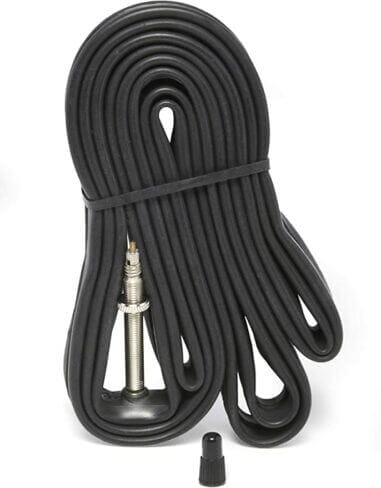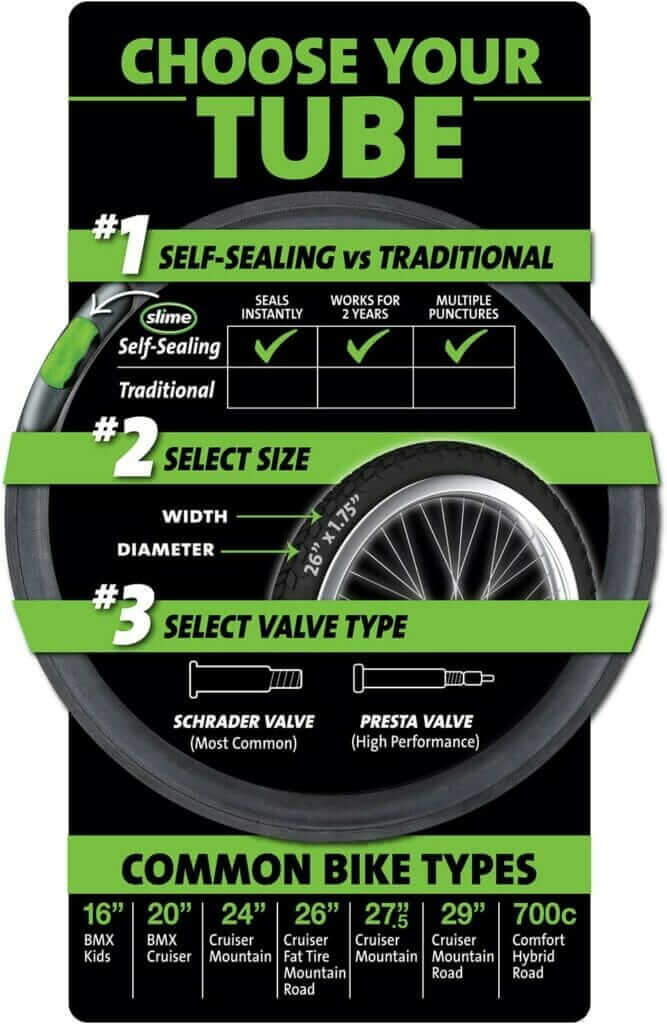Last Updated on June 4, 2023 by Vinson Lozano
Are you tired of constantly fiddling with your bike tires, fixing punctures, and dealing with flats? As a gravel bike enthusiast, you know the frustration that comes from having your ride interrupted by such annoyances.
You also know that riding on uneven terrain can be rough on your tires, making the debate between gravel bike inner tubes and tubeless systems more relevant than ever.
Before your next off-road adventure, let’s dig into the differences between traditional inner tubes and the increasingly popular tubeless tire setups.
In this blog post, we will explore their pros and cons as well as help you determine the optimal choice based on your gravel biking needs. So, grab a beverage, sit back, and let’s unravel the mysteries of gravel bike tire setups, ensuring you have a smooth ride and leave your worries behind!

Pros and cons of tube vs tubeless gravel bike tires
When it comes to gravel bike tires, riders often contemplate whether to choose the traditional inner tubes or go for the increasingly popular tubeless option.
Each system has its pros and cons, and selecting the ideal one for you will depend on your riding style and needs. Let’s discuss some of the advantages and disadvantages of both setups.
Tubeless tires provide some clear benefits for off-road and gravel biking. Firstly, they can self-seal small punctures, thanks to the liquid sealant inside the tire.
This reduces the likelihood of flats and allows for less interruption during your ride. Additionally, tubeless tires can be used with lower air pressures, which significantly enhances traction and ride comfort. This increased grip allows for better cornering and climbing, especially on loose or slippery surfaces.
Moreover, tubeless setups eliminate the possibility of pinch flats, which can occur when inner tubes are used.
However, tubeless setups also come with some drawbacks. Certain tire and rim combinations can be difficult to install and maintain a reliable seal. Also, if a spoke breaks or if the rim tape requires replacement, the process can become quite messy due to the sealant. The sealant itself dries up over time and needs periodic replenishment.
Furthermore, even with tubeless tires, riders still need to carry a spare tube in case of larger punctures or sidewall tears that cannot be sealed by the sealant.
On the other hand, inner tubes are easier to install and maintain, and there is a wider variety of tire options available. But, they offer less puncture resistance, and flats are more common compared to tubeless setups. Riders choosing inner tubes also may have to sacrifice some traction and comfort due to higher required air pressures.
In conclusion, the decision between tubeless and inner tubes for gravel bike tires will ultimately depend on your priorities and willingness to maintain the system. If puncture resistance and enhanced traction are the main concerns, tubeless tires are worth considering. However, if ease of installation and maintenance is more important, inner tubes might be the better choice.
How tubeless tires work and their construction
Tubeless tires have become a popular choice for many cyclists, especially for those tackling gravel terrain. They work by forming an airtight seal with the rim of the wheel, eliminating the need for an inner tube. The construction of these tires and how they function is an interesting aspect of their growing popularity.
To create an airtight seal, tubeless tires are made with a tight-fitting bead that locks onto the rim, preventing air from escaping. A valve, similar to the one found on an inner tube, is fitted directly to the rim.
The tire’s design and material must also ensure that it doesn’t leak air; hence, tubeless tires are often made of slightly thicker rubber compared to standard clincher tires.
An essential component of a tubeless setup is the sealant, which is either poured into the tire or injected through the valve. This sealant remains liquid inside the tire, and upon encountering any tiny leaks or small punctures while riding, it quickly fills the gaps and prevents air from escaping.
The main advantage of tubeless tires compared to their tubed counterparts is their ability to be run at lower tire pressures without the risk of pinch flats.
The absence of an inner tube and the self-sealing properties of the tire provide a more puncture-resistant and comfortable ride, both of which are particularly significant when navigating uneven gravel surfaces. However, it’s essential to remember that tubeless tires require more maintenance, including regular checks of the sealing and tire pressure, to ensure optimal performance.
Advantages of tubeless tires for reduced flats and improved traction
One of the main advantages of tubeless tires is the significant reduction in flats, providing cyclists with a more seamless and enjoyable ride. Unlike their tubed counterparts, tubeless tires don’t require an inner tube to hold the air inside. Instead, they form an airtight seal with the rim and valve, much like car or motorcycle tires. The absence of an inner tube eliminates the risk of pinch flats or snake bites, which occur when the tire compresses against the rim, tearing the tube, and causing a flat.
In addition to fewer flats, tubeless tires self-repair when punctured, thanks to the specially designed liquid sealant inside them. This sealant fills any holes created by nails, thorns, or other debris encountered on the road or trail, preventing the air from leaking out and the tire from going flat. This significant reduction in flats allows cyclists to spend more time enjoying their ride without having to constantly stop and repair or replace their tubes.
Another significant advantage of tubeless tires is their ability to offer improved traction during a ride. With no concerns about pinch flats, cyclists can run tubeless tires at much lower air pressure, typically around 10 psi lower than tubed tires. The reduced pressure increases the contact between the tire tread and the ground, greatly enhancing traction, especially during cornering and climbing. This improved grip is particularly beneficial when cycling on loose or slippery surfaces, providing a safer and more efficient ride. Overall, tubeless tires offer a more reliable and high-performing cycling experience to riders, thanks to their impressive resistance to flats and superior traction.
Converting existing wheels and tires to tubeless
Many cyclists are opting for tubeless bike tires due to their numerous advantages such as fewer flats, better traction, and improved rolling resistance. Fortunately, if you are considering making the switch, it is possible to convert your existing wheels and tires to a tubeless setup. This process typically involves using a tubeless conversion kit or following a DIY method.
First, it’s important to ensure that your current rims and tires are tubeless-compatible. Most modern wheels and tires are labeled as ‘tubeless-ready’ or have the UTS (Universal Tubeless System) marking, making the conversion process easier. The key to successful conversion lies in achieving an airtight seal between the tire, rim, and valve.
To start, remove your existing inner tubes and clean the rim surface thoroughly. Apply tubeless rim tape to create a properly sealed rim bed, taking care to cover all spoke holes and the valve hole. Once the rim tape has been applied, mount a tubeless-compatible tire and insert a tubeless valve through the valve hole. The valve should have a removable core to facilitate adding sealant later.
Pour 30ml (approximately) of liquid tire sealant into the tire cavity, making sure it spreads evenly inside. Reinstall the valve core and inflate the tire to the recommended pressure. The sealant will help create an airtight seal, as well as fill any punctures encountered while riding.
Perform a final check to ensure that the tire sits evenly on the rim, and the bead-locks are properly engaged. It’s a good idea to go for a short test ride to confirm that the tire is holding air and maintaining pressure as required. With a successful conversion, you can enjoy the benefits of tubeless tires on your existing wheels without the need for a complete overhaul.
Best Selling 700c Inner Tubes for Gravel Bike

Ultraverse Bike Inner Tube with 48mm Presta Valve
Treat your bike to a new inner tube with the Ultraverse Bike Inner Tube with 48mm Presta Valve. This top-of-the-line inner tube is designed to provide superior puncture resistance and lasting performance so you don’t have to worry about flats on your ride. The included tire levers make changing out an old tube for this one even easier, so you can get back on the road quickly.

VeloTubes 700C for Road Bike and Gravel
If you’re looking for a reliable, lightweight tire for your gravel bike, VeloTubes 700C are the perfect choice. These tires are designed with a 48mm Presta valve, which provides a secure seal and ensures that your ride is as smooth as possible. With their superior traction and puncture resistance, these tires will give you the confidence to tackle any terrain. Plus, they’re made from durable materials that are built to last. So if you’re looking for an exceptional tire to conquer the trails with, VeloTubes 700C is definitely worth considering.

Slime Bike Inner Tube with Slime Puncture Sealant
Slime Bike Inner Tubes with Slime Puncture Sealant are a great way to keep your bike running smoothly and safely. This product is designed to provide a permanent puncture sealant that can be used on any type of bicycle tire. It is an easy-to-use solution that helps prevent flat tires and provides long-term protection against punctures. The Slime Puncture Sealant seals punctures up to 1/8” in diameter and works on both tubeless and traditional tires. With this product, you can enjoy the convenience of not having to worry about flats or punctures while out on the road or trail.


